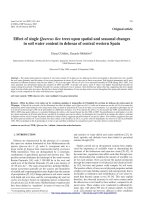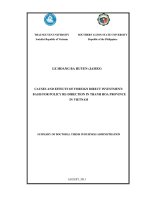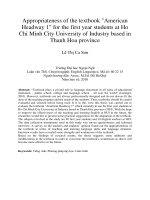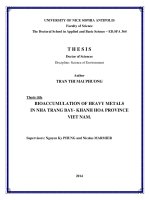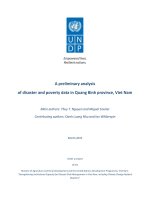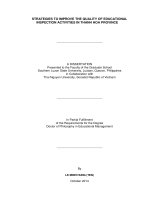Soil water repellency in red pine and hevea brasiliensis forest in thanh hoa province viet nam
Bạn đang xem bản rút gọn của tài liệu. Xem và tải ngay bản đầy đủ của tài liệu tại đây (568.98 KB, 22 trang )
MINISTRY OF AGRICULTURE AND RURAL DEVELOPMENT
VIETNAM FORESTRY UNIVERSITY
STUDENT THESIS
SOIL WATER REPELLENCY IN RED PINE AND HEVEA BRASILIENSIS
FOREST IN THANH HOA PROVINCE, VIETNAM.
Major: Natural Resources Management (Advanced Curriculum)
Code: D850101
Faculty: Forest Resources and Environmental Management
Student: Le Huy Cong
Student ID: 1153090917
Class: K56 Natural Resources Management
Course: 2011 - 2015
Advanced Education Program
Developed in Collaboration with Colorado State University, USA
Supervisor: Adjunct Associate Professor Dr. Phung Van Khoa
Co-advisor: Professor Lee MacDonald
22Tr
Hanoi, October 2015
1
ACKNOWLEDGEMENT
Firstly, I would like to express my sincere gratitude to my advisor Ph.DPhung Van
Khoa for constant support and valuable guidance during the time of research and writing of
this thesis.
Secondly, I would also thank various professors of Forestry University and Colorado
State University, especially professor MacDonald for providing classes and guidance for this
project.
Thirdly, I would like to thank people who working in Ha Trung and BaiChanh . They
provided good conditions when I conducted my research.
Finally, I would like to thank my family for giving birth to me and supporting me
spiritually throughout my life.
Hanoi, November 2015
2
TABLE OF CONTENTS
ACKNOWLEDGEMENT ......................................................................................................... 1
ABSTRACT ............................................................................................................................... 4
I. INTRODUCTION .................................................................................................................. 1
II. GOAL AND OBJECTIVES.................................................................................................. 3
2.1. Goal ................................................................................................................................ 3
2.2. Specific objectives ......................................................................................................... 3
III. METHODS .......................................................................................................................... 4
3.1. Study sites ...................................................................................................................... 4
3.2. Sample sites .................................................................................................................... 6
3.3. Water repellency assessment .......................................................................................... 6
3.4. Soil moisture .................................................................................................................. 7
3.5. Data analysis .................................................................................................................. 7
IV. RESULTS AND DISCUSSIONS ....................................................................................... 8
4.1. Evidence of Water repellency (WDPT) ......................................................................... 8
4.2. Soil moisture vs WDPT ............................................................................................... 11
V. RECOMMENDATION ...................................................................................................... 14
5.1. Effects of slight water repellency in study sites ........................................................... 14
5.2. Soil moisture ................................................................................................................ 15
5.3. Research limitation....................................................................................................... 15
5.4. Further study ................................................................................................................ 16
VI. CONCLUSION.................................................................................................................. 17
VII. REFERENCES ................................................................................................................. 18
3
ABSTRACT
There are evidences of water repellency in variety of soil conditions. The priority of
this research is simply describe method for determining the presence of water repellency in a
soil by using a metal corer and applying Water drop penetration time (WDPT) test at
different depths of soil samples. Published study has showed that organic matter, burn
severity, soil texture and soil moisture are some main factor that affect the severity of water
repellency. In this research, observations were made in order to identify the relationship
between soil moisture, bulk density and WDPT. WDPT presents strongest at the top soil and
rarely appear at other depths. The data suggest soil moisture threshold of approximately 2%
for red pine forest and up to 16% for Heveabrasiliensis forest. All data were collected under
dry conditions from July, 8 to July,13, 2015. Each plantation type was assessed by 4 sample
sites.
4
I. INTRODUCTION
Water repellencyis a natural occurring phenomenon that can be understood as the soil
ability to prohibit water from wetting or infiltrating dry soil. It has been described since 1910
when Schreiner and Shorey found some soils in California that could not be wetted and
unsuitable for agriculture. Since then, there was a remarkedly increase concern in water
repellency, over 100 papers have been published. It is of considerable interest because its
presence can cause a marked reduction in infiltration rate which commonly presumed the
primarily cause of the increase in runoff and erosion. A number of factors are believed to
control the strength of soil water repellency such as fire, vegetation type, soil texture, soil
moisture and time since burning (DeBano, 1981; de Jongeet al., 1999; DeBano, 2000a,
2000b; Doerr and Thomas, 2010). It is widely accepted that water repellency is caused by the
presence of organic compounds with hydrophobic properties on soil particle surfaces
(Doerret al., 2000). Water repellency in soils has been reported worldwide in grasslands
(Dekker and Ritsema, 1994), shrublands (Ferreira et al., 2005), croplands (Bisdom et al.,
1993), areas burned by widefires (Huffman et al., 2001; MacDonald and Huffman, 2004),
golf greens (Miller and Wilkinson., 1997) and forests. The forest vegetation types most
commonly associated with water repellency are evergreen tree species such as pine (Wahl et
al., 2003; Keizer et al., 2005), as well as oak (Cedraet al., 1998) and eucalypt (Crockfordet
al., 1991; Doerret al., 2002) species and tree with a considerable amount of resins, waxes or
aromatic oils are well presented (Doerr et al., 2000).
Given the background above and base on the fact that there is still little study about
water repellency in Vietnam, this paper aims to find evidence of water repellency in some
vegetation types in Vietnam. Because of the limited time and money, this study just focus on
vegetation types that provision a potential of water repellency in unburned area. As
mentioned above, water repellency are well presented in site that has a considerable amount
1
of resins, waxes and aromatic oils, therefore red pine forest and euphorbia forest were
selected to be the study sites because those species produce a great amount of waxes and oils
to the surface layer. Note that soil can be wetted after raining, therefore all the measurements
were conducted under dry conditions, if there was any occurrance of rainfall then the
measurement would be delayed by 4-5 days until the soil got dry again. There are many
techniques for measuring water repellency, this study apply the most common method called
Water Drop Penetration Time (WDPT). In the WDPT test water drops are applied to the soil
being tested and the investigator simply notes how long it takes until these water drops are
absorbed into the soil ( Doerr, Shakesby and MacDonald, 2007). The samples were also taken
and brought to lab in order to measeure moisture content and using graph to illustrate how
soil moisture and WDPT interact. The appropiate forest that can match the requirement of
evidence of water repellency is red pine and hevea brasiliensis forest. Thus, this study were
conducted in Thanh Hoa province where available for a potential amount of those forests.
Experiments were taken place in July, 2015 under dry conditions.
* Hypothesis:
- Soilwaterrepellency of the observed plantations is at slight severity ( with regard of median
WDPT ranges from 5-30s)
- Water repellency is indirect proportion to soil moisture
2
II. GOAL AND OBJECTIVES
2.1. Goal
Assessing the soil water repellency in red pine forest and hevea brasiliensis forest.
2.2. Specific objectives
(i) measure the strength of soil water repellency at different soils depth in red pine, hevea
brasiliensis forest.
(ii) relate the observed water repellency to vegetation type, soil moisture.
3
III. METHODS
3.1. Study sites
Ha Trung district
The first investigation relating to soil water repellency in red pine forest took place in
Ha Trung Scientific research and forestry technology application center. Ha Trungdistrict
lies in the North part of ThanhHoa province, with the coordination: 19059 – 20009 N and
105045 – 105058 E. The terrain gradually tilted from northwest to southeast. The
northwestern area is surrounded by many high hills which made the Ha Trung district, though
plain but more diversity. As the result, in rainy season, there's often flooding that put locals in
many difficulties. The average annualtemperature is 23oC in which the maximum temperature
is 41oC and and the minimum temperature is 6oC. Average humidity range from 85% to 87%
with highest peak 92% fall in January, February, in contrast, June and July record the lowest
humidity. The average annualprecipitation over the district is 1.700 mm. It is reported that the
highestannual precipitation peak at 2.800 mm and the lowest one is 1.100 mm. Due to the
unequal distribution of precipitation among months of the year, crop productivity has been
strongly affected. Rainy season often last from May to October with average 250-270 mm per
month, precipitation with greater amount mainly appear in August, September and October,
in some particular year, it is up to 800 mm for just one month. Dry season occurs from
November to April of the next year. [...] Ha Trung district offers a fairly large forested area
with variety of plants. Total forestry area up to 2009 is 5.430,78 hectares in which 60% of
those is productive forest land (3.436,39 hectares), 20% reserved forest and special forest
accounted for 2%.
4
Figure 3.1. Ha Trung Scientific research and forestry technology application center
(Google map)
Bãi Trành commune
Research on soil water repellency of hevea brasiliensis forestwas conducted in
BãiTrành, a village of NhưThanh district. Longitude of NhưXuân: 109.141924 Latitude of
NhưXuân: 12.287020
Figure 3.2. Bai Tranh commune, Thanh Hoa (Goole map)
5
3.2. Sample sites
At each plantation type, 4 separated sites were established in order to take soil sample
and measure WDPT. To take soil sample, a metal corer were used and soil sample were
collected from the surface to the depth of 6 cm vertically after sweeping out all the dead
leaves and others coverage materials , at deeper elevation, soil were taken horizontally. The
volume of a cylindrical cup is 100 ml. Total of 8 samples from two plantations were surveyed
from July, 8th to July, 12th, 2015. It is very important to preserve all soil samples before
conducting experiment in lab, the collected soil then will be packaged in black plastics in
order to prevent sunlight effect.
3.3. Water repellency assessment
Water repellency test was taken in the field by using the WDPT test. A set of 8 study
sites were identified in July 2015. WDPT test was assessed at the mineral soil surface and
depths of 3, 6, 9, 12 and 15 cm. At each depth the WDPT was determined by applying at least
five drops of water. Drop penetration time was recorded using a stopwatch. For field
collection purposes, I used the following drop penetration time classification scheme: 0s - 1s
= not repellent, 1s - 5s = very low repellency, 5s - 30s = slight repellency, 30s - 180s =
moderate repellency, and >180s = high repellency (Robichaud 1996). These water repellency
indices were further modified by combining 0s to 1s and 1s to 5s, 30s to 180s and >180s to
give the following classification scheme: 0s to 5s = wettable, 5s - 30s = slight water
repellency and >30s = moderate and high repellency (Hubbert and Oriol 2005). The
measurement was replicated 10 times at each depth and if the water repellency was found
consistently from depth to depth, the measurement would be continued until 15 cm depth. In
contrast, if there was no water repellency at 3 cm, then 6 cm, we can decide not to test WDPT
for the next depth. The median time was used as the WDPT for that depth because it is less
sensitive to extreme values ( MacDonald and Huffman, 2007)
6
3.4. Soil moisture
At each pit one soil sample is taken from 0-5 cm and another from 9-12 cm then
weighted, dried and weighted again to detemine percent moisture. The effect of soil moisture
was analyzed by plotting surface soil moisture content against the WDPT values from 0 - 5
cm. The WDPT data from 0 - 5 cm were used because these depths exhibited the strongest
water repellency and were more accurately characterized by the 0 - 5 cm samples used to
determine soil moisture. Visual examination of these scatter plots was used to determine
thehighest moisture content associated with evidence of soil water repellency. The highest
moisture content with evidence of soil water repellency was assumed to represent the soil
moisture threshold for that burn severity class. In this research, only soil from 0-5 cm depth
was analysed and then plotted against WDPT in order to identify the relationship between
those factors.
3.5. Data analysis
The soil water repellency was first compared by depth at each plantation if evidence
of water repellency was found. The first step is identify the relationship between WDPT and
soil moisture in red pine forest. Plot median of WDPT against soil moisture brought a
graphical outcome that show how soil moisture has affected the time of a drop being
absorbed into soil. The second step is similarly plot WDPT agaisnt soil moisture in hevea
brasiliensis forest in order to identify the relationship of them. Then see if any similarity
between these plantations. It is advised that the surface soil would display the most
significance of water repellency rather than other depths.
7
IV. RESULTS AND DISCUSSIONS
4.1. Evidence of Water repellency (WDPT)
Table 4.1. Median WDPT of red pine and hevea brasiliensis
Forest
Median WDPT
Site
status
surface
3 cm
6 cm
9 cm
1
Red pine
10
2
1
x
2
Red pine
8,5
1
1
x
3
Red pine
8
1,5
1
x
4
Red pine
17,5
2
1,5
x
5
hevea brasiliensis
10
2,5
2
x
6
hevea brasiliensis
8
2,5
1
x
7
hevea brasiliensis
5,5
2
2
x
8
hevea brasiliensis
11,5
3
1
x
Red pine
WDPT vs Depth
hevea brasiliensis forest
WDPT vs Depth
20
20
10
10
0
0
P1
surface
P2
P3
3cm depth
P4
P5
6 cm depth
surface
Figure 4.1. WDPT at different depth
8
P6
P7
3cm depth
P8
6 cm depth
20
12
10
8
6
4
2
0
15
10
Median
WDPT
Median
WDPT
5
0
0
3
6
9
0
Depth (cm)
3
6
Depth (cm)
Plot 1
Plot 2
20
15
10
Median
WDPT
5
0
0
3
6
9
10
8
6
4
2
0
Median
WDPT
0
9
3
6
9
Depth (cm)
Depth (cm)
Plot 3
Plot 4
10
15
8
10
6
4
Median
WDPT
5
Median
WDPT
2
0
0
0
3
6
9
0
Depth (cm)
3
6
9
Depth (cm)
Plot 5
Plot 6
6
15
4
10
Median
WDPT
2
Median
WDPT
5
0
0
0
3
6
9
0
Depth (cm)
3
6
9
Depth (cm)
Plot 7
Plot 8
Figure 4.2. WDPT at different depth in each plot
9
It is clear that water repellency are well-presented at the surface of all sample sites.
However, there is a wide difference among time absorptions. While site 1, 3, 4 (red pine) and
7, 8 (hevea brasiliensis ), time for penetrating a water drop can last for 58, 117, 50 and 96,
176 seconds respectively, other sites report much faster time for a drop penetration as just
under 5 seconds. Due to this wide difference, the median value of WDPT was put into
consideration because it provides the most accurate index of soil water repellency, unlike the
mean value which can be greatly affected by one or few drops with very long penetration
times. In addition, WDPT rarely exist at other depths, most of the data showed that there is a
very weak water repellency that present at the depth of 3 cm , 6 cm and downward, it took
only 1 to 3 seconds to absorb every drop. This can easily be explained as in general, the top
centimeters or decimeters of soil always contain organic molecules with hydrophobic
properties. According to Huffman, 2001, under unburned conditions, the soil water
repellency is typically strongest at the surface of the mineral soil and drops off rapidly with
depth. In this observation, both type of plantations showed evidence of water repellency and
indicated the strongest water repellency at the top soil minerals. Median WDPT ranges from
5.5 - 17.5 seconds, the severity of water repellency in both forests is concluded as: slight
water repellency
Figure 4.3. Water droplets resisting infiltration into soil due to water repellency
10
4.2. Soil moisture vs WDPT
Table 4.2. Median WDPT and Soil moisture
Forest
Site
Median WDPT
Median WDPT
(3cm depth)
(surface)
Soil moisture
status
1
Red pine
2,7
2
10
2
Red pine
1,0
1
8,5
3
Red pine
1,4
1,5
8
4
Red pine
3,1
2
17,5
5
hevea brasiliensis
16,9
2,5
10
6
hevea brasiliensis
15,9
2,5
8
7
hevea brasiliensis
13,4
2
5,5
8
hevea brasiliensis
19,9
3
11,5
In general, the soil moisture of these two forest types are fairly low, just under 20%.
With this soil moisture content, it is predicted that there would be very low water repellency
because normally, water is highly attracted by dry soil. Soil moisture of 8 sites are fairly low
as about 15% in hevea brasiliensis forest and much lower with just about 2% in average in
red pine forest. The results from soil moisture measurementsintwo plantations showed that
when soil moisture increases, time required for a drop to be absorbed increases as well, this
also means that the wetted soiled that caused by temporal weather condition such as rain or
night-time fog will lead to a decline in the strength of soil water repellency. However, other
studies suggested that soils become less or even completely lose their water repellency as soil
moisture increases. According to Dekker, at a certain soil moisture, the soil changes from
being water repellent to wettable, there is also evidence that soil moisture increase with
increasing burn severity (MacDonald, Huffman, 2004).
11
Relationship between WDPT and soil moisture in red pine forest
MEDIAN WDPT (S)
15
10
17.5
3,2
3.5
3
Soil moisture
2.5
2,6
2
10
8.5
8
1,0
1,4
1
1.5
1.5
1
5
2
2
0
SOIL MOISTURE (%)
20
Median WDPT
0.5
Median WDPT
0
1
2
3
4
Relationship between WDPT and soil moisture in hevea
brasiliensis forest
14
25
19,9
10
8
16,9
10
13,4
15
8
6
4
20
11.5
15,9
5.5
2.5
2.5
10
3
2
SOIL MOISTURE (%)
MEDIAN WDPT (S)
12
5
2
0
0
5
6
7
8
Figure 4.4. Relationship between median WDPT and soil moisture
At the beginning of this research, it was aimed to find the connection between soil moisture
and water repellency at different depths. According to the observation, water repellency was only
performed at the surface layer, therefore it is not necessary to take soil from every depths (only
need from 0-5 cm depth) for the measurement of moisture content. In this case, the results indicated
how soil moisture content interact with median WDPT of the soil surface from 4 Euphorbia plots,
as well as for 4 red pine plots. There was similarity in the absorption time at the depth of 3 cm
while more significant difference has shown for the topsoil. With higher soil moisture, the drops
need more time to be completely absorbed.
12
* Correlation: Soil moisture vs.WDPT
Correlation
Soil moisture vs WDPT (red
pine forest)
20
Median WDPT
Median WDPT
15
y = 3.5018x + 3.7402
R² = 0.683
15
y = 0.9484x - 6.9635
R² = 0.9442
10
10
y = 0.432x + 0.7295
R² = 0.8843
5
Correlation
Soil moisture vs WDPT( hevea
brasiliensis forest )
0
WDPT (surface)
Linear (WDPT
(3cm))
y = 0.1513x - 0.0063
R² = 0.9729
5
Linear (WDPT
(surface))
0
0
2
4
0
soil moisture
WDPT (3cm)
20
40
soil moisture
Figure 6a: Correlation of soil moisture
Figure 6b:Correlation of soil moisture
and median WDPT in red pine forest
and median WDPT in hevea brasiliensis forest
These scatterplots illustrate how connect between soil moisture and WDPT at two
different depths (3cm depth and topsoil layer). In both cases, it is more correlated at 3cm
depth than at the surface. The standard deviation were all greater than 0.6 which means the
soil moisture in the surveyed forests were strongly connected with water repellency follow
the upward linear function (y = ax + b) Clearly, a comparision of figure it is understood as
when soil moisture content increases, the strength of water repellency increases as well. This
means soil with greater humid will absorb water slower than dry soil. The soil moisture were
up to 20% in dry condition, yet the lack of WDPT data at higher soil moisture content
precludes the identification of soil moisture threshold at higher severity.
13
V. RECOMMENDATION
5.1. Effects of slight water repellency in study sites
Clearly, the capacity of soil to infiltrate water in two plantations are still strong with
very slight water repellent existance. Therefore, its impact will be small which means the
appearance of water repellency does not really matter to runoff and erosion in these two
plantations. Besides, by observation, water repellency was not an isolated factor to control
infiltration rate, in Ha Trung centre, for example, the surface cover plays an important role in
reducing the intention of waterdrops before reaching the surface.
Figure 5.1. Dead leaves and grasses to cover the surface of red pine forest
In contrast, human disturbance in Bai Tranh must be noted as a real effect to the soil
water repellency. In hevea brasiliensis forest, trees were planted in line and the workers came
there to take the sap twice a week. In addition, in almost hevea forest, there were no surface
cover and it all exposed to the sun and the rain. To combine, workers' activities can cause
compaction to the soil, sunlight can burn out the organic compounds easily and rainfall with
high intensity can cause some detachment of soil particles.
14
Figure 5.2. Hevea brasiliensis forest in Bai Tranh commune
5.2. Soil moisture
The results showed for soil moisture were controversy to other studes and still need
discussion. Currents idea on soil moisture is that it can break down under prolonged contact
with water and does not re-establish above a soil-specific moisture threshold. The undone is
whether in two plantations there was any threshold that could not found during the fieldwork.
5.3. Research limitation
First, it would be better if we study on both soil texture and soil moisture so that more
conviniences can be made in comparision to water repellency. Second, the study need to put
emphasis on the effects of water repellency rather than just observe the norm. In addition, the
aims of this study is to find evidence of soil water repellency in different vegetation types
especially forests, then two plantations is still an inappropriate number. However, due to the
limitation of time and money, this study can only made for two palntations.
15
5.4. Further study
In the future, study should be made in variety of plantations that available in Vietnam
and from that we can draw a map of water repellent distribution in Vietnam plantations. From
this map we will know in which location, water repellency are strong or low then more
emphasis would be devoted for plantations with high severity of water repellency. To reduce
it effects, what approach should be done is another key questions and it required our experts
to get involve.
16
VI. CONCLUSION
Water repellency was found in red pine forest and hevea brasiliensis forest in Thanh
Hoa province with slight severity under dry condition. It is clear that water repellency was
well-presented at the topsoil layer and almost disappear at other depths. Isolating from other
effects, with slight severity of water repellency, the impacts are not significant. Regarding to
soil moisture content, as soil moisture content increases, there was also an increase in time of
soil water absorption. The average soil moisture is approximately 2% for red pine forest,
20% for hevea brasiliensis forest. Overall, it is also needed to study how these water
repellency influent the soil preventative under wet conditions, especially in rainy season.
17
VII. REFERENCES
DeBano LF. 1981. Water repellant soils: a state-of-the-art. Gen. Tech. Rep. PSW46, illus. Pacific Southwest Forest and Range Exp. Stn.,Forest Serv., US Dep. Agric.:
Berkley, CA; 21.
Doerr SH, Shakesby RA and MacDonald LH, 2001. Chapter I.7 Soil water repellency:
A key factor in Post-fire Erosion?
Doerr SH, Shakesby RA, Wash RPD, 2000. Soil water repellency: its causes, characteristics
and hydro-geomorphological significance. Earth-Science Reviews 51(2000) 33-65
Doerr, SH., and A.D. Thomas. 2000. The role of soil moisture in controlling water
repellency: New evidence from forest soils in Portugal. J. Hydrol. (Amsterdam) 231-232:134147
Huffman EL, MacDonald LH, Stednick JD, 2001. Strength and persistence of fire-induced
soil hydrophobicity under ponderosa and lodgepole pine, Colorado Front range
Http://geography.swansea.ac.uk/hydrophobicity/publications.htm
Hallett PD, 2007: An introduction to soil water repellency
MacDonald LH, Huffman EL, Post-fire Soil Water Repellency: Persistence and Soil Moisture
Thresholds
Shakesby, R.A., S.H. Doerr, and R.P.D. Wash. 2000. The erosional impact of soil
hydrophobicity: Current problems and future research directions. J. Hydrol.
(Amsterdam) 231-232: 178-191
Wladitchensky, S.A. 1966. Moisture content and hydrophobicity as related to the water
capillary rise in soils. Symp. Int. Assoc. Sci. Hydrol. 82:360-365.
18

